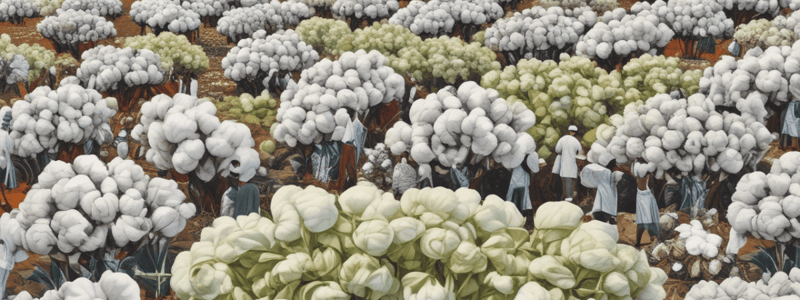Podcast
Questions and Answers
What percentage of global carbon emissions is accounted for by apparel production?
What percentage of global carbon emissions is accounted for by apparel production?
- 10% (correct)
- 20%
- 30%
- 5%
Fast fashion has reduced the environmental impact of the clothing industry.
Fast fashion has reduced the environmental impact of the clothing industry.
False (B)
What is the estimated number of people employed in the t-shirt industry in Bangladesh?
What is the estimated number of people employed in the t-shirt industry in Bangladesh?
4.5 million
In the United States, the average household does approximately ______________ loads of laundry per year.
In the United States, the average household does approximately ______________ loads of laundry per year.
What is the ranking of the fashion industry in terms of pollution, after oil?
What is the ranking of the fashion industry in terms of pollution, after oil?
Match the country with its ranking in cotton t-shirt exports.
Match the country with its ranking in cotton t-shirt exports.
Machine labor completely replaces human labor in the production of t-shirts.
Machine labor completely replaces human labor in the production of t-shirts.
How much did global production of garments increase from 1994 to 2014?
How much did global production of garments increase from 1994 to 2014?
What is the approximate amount of water required to produce the average t-shirt?
What is the approximate amount of water required to produce the average t-shirt?
True or False: Organic cotton makes up more than 50% of the global cotton production.
True or False: Organic cotton makes up more than 50% of the global cotton production.
What is the primary purpose of an industrial cotton gin in the production of t-shirts?
What is the primary purpose of an industrial cotton gin in the production of t-shirts?
The cotton plants require a huge quantity of ___________ and pesticides.
The cotton plants require a huge quantity of ___________ and pesticides.
Match the following stages in the production of a t-shirt with their corresponding descriptions.
Match the following stages in the production of a t-shirt with their corresponding descriptions.
What percentage of textiles contain vivid coloring made possible by commercial bleaches and azo dyes?
What percentage of textiles contain vivid coloring made possible by commercial bleaches and azo dyes?
True or False: The average t-shirt is made from organic cotton.
True or False: The average t-shirt is made from organic cotton.
What is the approximate number of t-shirts sold globally each year?
What is the approximate number of t-shirts sold globally each year?
Flashcards are hidden until you start studying
Study Notes
Environmental Impact of T-Shirts
- Annually, 2 billion t-shirts are sold globally, making it one of the most common garments in the world.
Cotton Production
- Cotton seeds are sown, irrigated, and grown in farms in America, China, or India.
- Cotton plants require a huge quantity of water (2,700 liters) and pesticides.
- Cotton uses more insecticides and pesticides than any other crop in the world, causing harm to health and ecosystems.
Cotton Processing
- Cotton lint is pressed into 225-kilogram bales.
- Cotton bales are shipped to textile mills in China or India for spinning.
- Machines blend, card, comb, pull, stretch, and twist the cotton into yarn.
Fabric Production
- Yarns are sent to the mill to weave into sheets of rough grayish fabric.
- Fabric is treated with heat and chemicals to turn soft and white.
- Fabric is dipped into commercial bleaches and azo dyes, which contain cancer-causing cadmium, lead, chromium, and mercury.
Labor and Manufacturing
- Human labor is required to stitch the fabric into t-shirts in factories often in Bangladesh, China, India, or Turkey.
- Bangladesh employs 4.5 million people in the t-shirt industry, but they typically face poor conditions and low wages.
Transportation and Carbon Footprint
- T-shirts travel by ship, train, and truck to be sold in high-income countries, giving cotton an enormous carbon footprint.
- Apparel production accounts for 10% of global carbon emissions, which is escalating.
Consumer Impact
- The average household does nearly 400 loads of laundry per year, each using about 40 gallons of water.
- Washing machines and dryers use energy, with dryers requiring five to six times more than washers.
Environmental Consequences
- Fast fashion has cost the environment, farmers' health, and driven questionable human labor practices.
- Fashion has become the second largest polluter in the world after oil.
Sustainable Solutions
- Consider shopping secondhand.
- Look for textiles made from recycled or organic fabrics.
- Wash clothes less and line dry to save resources.
- Donate, recycle, or reuse old clothes instead of throwing them away.
- Reflect on personal consumption and its combined impact on the world.
Studying That Suits You
Use AI to generate personalized quizzes and flashcards to suit your learning preferences.




